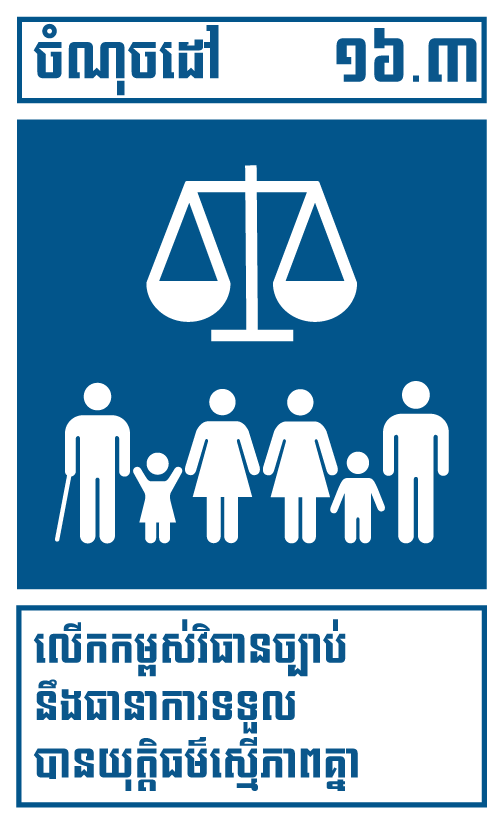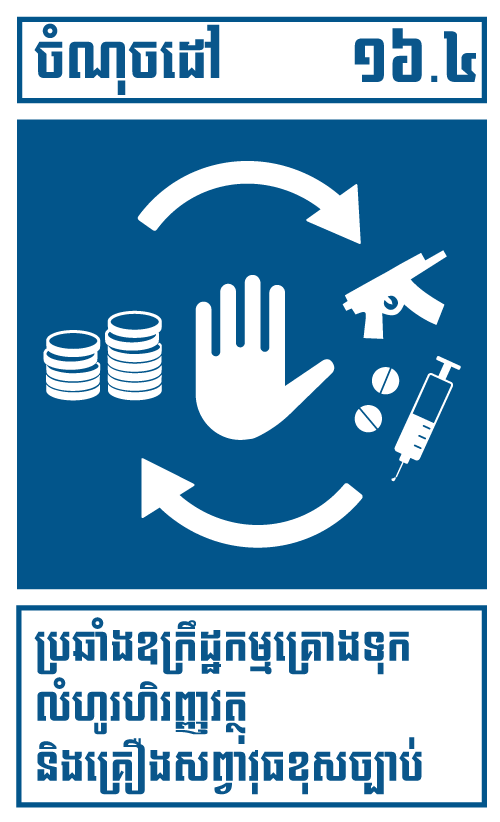ចំណងជើងពេញរបស់គោលដៅទី១៦ គឺ “លើកកម្ពស់សង្គមដែលមានសន្តិភាព និងប្រកបដោយបរិយាប័ន្ន ដើម្បីការអភិវឌ្ឍប្រកបដោយចីរភាព ផ្តល់នូវការទទួលបានយុត្តិធម៌សម្រាប់ប្រជាជនគ្រប់រូប នឹង កសាងស្ថាប័នដែលមានប្រសិទ្ធភាព គណនេយ្យភាព និងបរិយាប័ន្ននៅគ្រប់កម្រិត”។ គោលដៅនេះ មានក្របខ័ណ្ឌត្រួតពិនិត្យមួយ សម្រាប់ចំណុចដៅចំនួន១២ ក្នុងនោះរួមមានមធ្យោបាយនៃការអនុវត្តគោលដៅចំនួន ២ និងសូចនាករចំនួន ២៣។
 |  |  |  |
 |  |  |  |
 |  |  |  |
|---|
ការផ្លាស់ប្តូរពីគោលដៅអភិវឌ្ឍន៍សហស្សវត្សរ៍ ទៅជាគោលដៅអភិវឌ្ឍន៍ប្រកបដោយចីរភាពទី១៦ នៅក្នុងប្រទេសកម្ពុជា
គ្មានគោលដៅណាមួយនៃគោលដៅអភិវឌ្ឍន៍សហស្សវត្សរ៍ពីមុន ដែលអាចប្រៀបនឹងគោលដៅអភិវឌ្ឍន៍ប្រកបដោយចីរភាពទី១៦នោះទេ។
ដំណើរឈានទៅរកគោលដៅទី១៦ គឺកើតចេញពីកំណើននៃការយល់ដឹងពី ភាពអយុត្តិធម៌ អសន្តិសុខ និងអំពើហឹង្សា ដែលអាចរារាំងដល់ការអភិវឌ្ឍ។
អង្គការអន្តរជាតិ International Bridges to Justice បង្ហាញថា គោលដៅអភិវឌ្ឍន៍ប្រកបដោយចីរភាពទី១៦នេះ “… គឺតំណាងឱ្យផ្នែកដ៏ធំមួយនៃមេរៀនជាច្រើន ដែលទទួលបានពីភាពជោគជ័យ នៃការអនុវត្តគោលដៅអភិវឌ្ឍន៍សហស្សវត្សរ៍…។ មូលដ្ឋានគ្រឹះ នៃគោលដៅអភិវឌ្ឍន៍ប្រកបដោយចីរភាពទី១៦ ពិពណ៌នា អំពីគោលបំណងមូលដ្ឋាន ដើម្បីឈានទៅរកភាពជោគជ័យនៃគោលដៅទាំងអស់។ 1
ការវាយតម្លៃចំណុចដៅសម្រាប់ប្រទេសកម្ពុជា រវាងចំណុចដៅសកល
ធនាគារអភិវឌ្ឍន៍អាស៊ី បានបង្ហាញទិន្នន័យមួយចំនួនជុំវិញសូចនាករសកលសម្រាប់ការអភិវឌ្ឍន៍ប្រកបដោយចីរភាព គោលដៅទី១៦នៅក្នុងតំបន់អាស៊ី។ 2 ស្ថិតិសម្រាប់ប្រទេសកម្ពុជាមាននិន្នាការធ្ងន់ធ្ងរ៖
- ចំណុចដៅ ១៦.១
– ១៦.១.១ ចំនួនជនរងគ្រោះដោយអំពើមនុស្សឃាតដោយចេតនា (ម្នាក់ក្នុងចំណោមប្រជាជន ១០០.០០០ នាក់)
ប្រទេសកម្ពុជាបានផ្លាស់ប្តូរពីចំនួន៤,៧ នាក់ (ម្នាក់ក្នុងចំណោមប្រជាជន ១០០.០០០ នាក់) ក្នុងឆ្នាំ២០០០ ទៅ ១,៨នាក់ នៅឆ្នាំ២០១១ ដែលជាការថយចុះយ៉ាងច្រើន ប្រៀបធៀបនឹង មធ្យមភាគនៃប្រទេសជាដៃគូរនៅអាស៊ីអាគ្នេយ៍ទាំង៩។ នេះតួលេខថ្មីបំផុត ដែលទាបជាង កម្រិតមធ្យម និងម៉េដ្យាន នៃបណ្តាប្រទេសដៃគូរបស់កម្ពុជា។
- ចំណុចដៅ ១៦.៣
– ១៦.៣.២ សមាមា្រតនៃជនជាប់ឃុំដែលមិនបានកាត់ក្តី ធៀបនឹងអ្នកជាប់ឃុំសរុប
ប្រទេសកម្ពុជាបានផ្លាស់ប្តូរពីចំនួន ២៩,៨ ភាគរយ ក្នុងឆ្នាំ ២០០៥ មកចំនួន ៥៩,២ ភាគរយ ក្នុងឆ្នាំ ២០១៤ ។ តួលេខនេះបានកើនឡើងទ្វេរដង។ តួលេខថ្មីនេះ គឺខ្ពស់បំផុត នៅប្រទេសអាស៊ីអាគ្នេយ៍ទាំងអស់ ក្រៅពីប្រទេសហ្វីលីពីន។ (ការវិភាគដាច់ដោយឡែកមួយបានរកឃើញថា ប្រទេសកម្ពុជា គឺជាប្រទេសដែលមានការកម្រិតប្រតិបត្តិអន់បំផុតទី៤ នៅលើពិភពលោក ចំពោះការរីកចំរើនក្នុងវិស័យនេះ។ 3
- ចំណុចដៅ ១៦.៥
– ១៦.៥.២ សមាមាត្រនៃក្រុមហ៊ុនដែលទទួលបានសំណើរសុំទូទាត់សំណូកយ៉ាងហោចណាស់មួយ
នៅឆ្នាំ ២០១៦ ប្រទេសកម្ពុជា មានតួលេខអំពើពុករលួយប្រភេទនេះ ៦៤,៧ ភាគរយ ដែលខ្ពស់បំផុតនៅអាស៊ីអាគ្នេយ៍ ដែលមានទិន្នន័យ ហើយច្រើនជាងពីរដង នៃប្រទេសក្នុងតំបន់របស់ខ្លួន។ (ការវិភាគដាច់ដោយឡែកមួយបានរកឃើញថាប្រទេសកម្ពុជា ស្ថិតក្នុងលំដាប់ទី២ ក្នុងចំណោមប្រទេសប្រតិបត្តិដ៏អាក្រក់បំផុតនៅលើពិភពលោក សម្រាប់វិធានការដូចគ្នានៃអំពើពុករលួយ)។[ដូចឯកសារយោងខាងលើ។]
- ចំណុចដៅ ១៦.៩
– ១៦.៩.១ សមាមាត្រនៃកុមារអាយុក្រោម ៥ឆ្នាំ ដែលបានចុះបញ្ជីជាមួយអាជ្ញាធរស៊ីវិល
នៅឆ្នាំ ២០១៤ ប្រទេសកម្ពុជា មានអត្រា ៧៣,៣ ភាគរយ ដែលស្ថិតក្នុងចំណាត់ថ្នាក់ទាបបំផុតទីពីរទី២ នៅក្នុងតំបន់អាស៊ីអាគ្នេយ៍ បើតាមទិន្នន័យដែលមានស្រាប់។
មានតែចំណុចដៅចុងក្រោយតែមួយប៉ុណ្ណោះនៃគោលដៅទាំងនេះ ដែលត្រូវបានគេយកទៅបញ្ចូលក្នុងពង្រាងនៃ គោលដៅអភិវឌ្ឍន៍ប្រកបដោយចីរភាពកម្ពុជា។ (ពន្យល់ខាងក្រោម)
របាយការណ៍វឌ្ឍនភាព ស្តីពីគោលដៅអភិវឌ្ឍន៍ប្រកបដោយចីរភាពទី១៦ ដោយវិទ្យាស្ថានសេដ្ឋកិច្ច និង សន្តិភាព (Institute for Economics and Peace) បានរកឃើញថា ប្រទេសកម្ពុជា គឺជាប្រទេសដែលស្ថិតក្នុងចំណាត់ថ្នាក់ទី៣ ដែលបានអនុវត្តមិនបានល្អ នៅលើពិភពលោក សម្រាប់ផ្នែក សេរីភាពក្នុងការទទួលបានព័ត៌មានជាសាធារណៈ (ចំណុចដៅទី ១៦.១០)។ 4 តែប្រទេសកម្ពុជាគឺជាប្រទេសដែលល្អបំផុតលំដាប់លេខ ២ នៅលើពិភពលោក មានអំពើហិង្សាផ្លូវភេទតិចលើកុមារ។ (ចំណុចដៅទី ១៦.២)
អង្គការ International Bridges to Justice បានអភិវឌ្ឍគម្រោង ទាក់ទងនឹងការទទួលបានយុត្តិធម៌ជាច្រើននៅជុំវិញពិភពលោក។ របាយការណ៍នេះ បានលើកឡើងថាកម្មវិធីរបស់ខ្លួននៅកម្ពុជា បាននាំឱ្យមានអត្រាធ្លាក់ចុះនៃការធ្វើទារុណកម្មស៊ើបអង្កេត នៅតាមខេត្តមួយចំនួន ដែលបណ្តាលមកពីការរំលោភបំពានជាប្រព័ន្ធនៅក្នុងស្ទើរតែគ្រប់ករណីទាំងអស់ អោយថយចុះតិចជាង ៥ភាគរយ នៃករណីទាំងអស់។ 5 វាស្ថិតនៅក្រោមចំណុចដៅទី ១៦.១។
យោងតាមសន្ទស្សន៍គោលដៅអភិវឌ្ឍន៍ប្រកបដោយចីរភាព និងរបាយការណ៍ស្តីពីកិច្ចព្រមព្រៀងឆ្នាំ ២០១៨ នៅក្នុងចំណុចចំនួនបួននៃ គោលដៅអភិវឌ្ឍន៍ប្រកបដោយចីរភាពទី១៦ របស់កម្ពុជា ដែលនិន្នាការត្រូវបានគេមើលឃើញថា កំពុងដើរថយក្រោយវិញ។ 6 មានតែចំណុចពីរប៉ុណ្ណោះ ដែលកម្ពុជាវាយតម្លៃបានល្អ គឺចំនួនប្រជាជនជាប់ពន្ធនាគារ ម្នាក់ក្នុងចំណោមប្រជាជន ១០០.០០០ នាក់ និងការផ្ទេរអាវុធដ៏ច្រើនសន្ធឹកសន្ធាប់។
វាមិនមែនជារឿងចំលែកទេ ដែលអ្នកសង្កេតការណ៍មួយចំនួនបានលើកឡើងថា គោលដៅអភិវឌ្ឍន៍ប្រកបដោយចីរភាពទី១៦ បានបង្ហាញពីបញ្ហាប្រឈមមួយសម្រាប់កម្ពុជា។ ការវិភាគមួយ អំពីការត្រៀមខ្លួនរបស់ប្រទេសកម្ពុជា សម្រាប់ការអនុវត្តគោលដៅអភិវឌ្ឍន៍ប្រកបដោយចីរភាព បានរកឃើញថា “គោលដៅរបស់ការអភិវឌ្ឍន៍ប្រកបដោយចីរភាពទី ១៦… នឹងក្លាយជាបន្ទុកដ៏ធ្ងន់សម្រាប់កម្ពុជា”។ 7 សេចក្តីអត្ថាធិប្បាយនេះ ត្រូវបានធ្វើឡើងមុនពេលគោលដៅ និងសូចនាករតាមតំបន់ត្រូវបានប្រកាស នៅចុងឆ្នាំ ២០១៨។
ការធ្វើមូលដ្ឋានីយកម្មគោលដៅទី១៦ នៅក្នុងប្រទេសកម្ពុជា
នៅឆ្នាំ ២០១៦ យូអិនឌីភី (UNDP) បានធ្វើការវាយតម្លៃរួមបញ្ចូលយ៉ាងឆាប់រហ័ស នៃផែនការយុទ្ធសាស្ត្រអភិវឌ្ឍន៍ជាតិ ២០១៤ - ២០១៨ របស់កម្ពុជា និងផែនការនិងយុទ្ធសាស្ត្រពាក់ព័ន្ធនានា ដោយធៀបនឹងគោលដៅអភិវឌ្ឍន៍ប្រកបដោយចីរភាពសកល។ 8 ការវាយតម្លៃនេះ បានផ្តល់ការវិភាគពីចំណុចខ្វះខាត របស់គោលដៅអភិវឌ្ឍន៍ប្រកបដោយចីរភាព ដែលមិនត្រូវបានលើកឡើង ឬត្រូវបានលើកឡើងដោយផ្នែកនៅក្នុងផែនការបច្ចុប្បន្ន និងគោលដៅដែលត្រូវបានលើកឡើងដោយវិស័យជាច្រើន។
ជាលទ្ធផលរួម គឺថាចំណុចដៅចំនួន ៨៥ ក្នុងចំណោមចំណុចដៅនៃគោលដៅអភិវឌ្ឍន៍ប្រកបដោយចីរភាពទាំង ១០៩ ត្រូវបានលើកឡើងយ៉ាងពេញលេញ។ ក្នុងចំណោមនោះ ១៧ចំណុចដៅ ត្រូវបានដោះស្រាយដោយផ្នែក និង គោលដៅចំនួន ៧ ដែលមិនត្រូវបានដោះស្រាយ។
“រដ្ឋាភិបាលបានផ្តល់អាទិភាពដល់អភិបាលកិច្ចល្អនៅក្នុងផែនការយុទ្ធសាស្ត្រអភិវឌ្ឍន៍ជាតិរបស់ខ្លួន។ ចំណុចដៅប្រមាណ ៧០ ភាគរយ នៃចំណុចដៅគោលដៅអភិវឌ្ឍន៍ប្រកបដោយចីរភាព ដែលទាក់ទងនឹងសន្តិភាព (គោលដៅទី១៦) ត្រូវបានលើកឡើងនៅក្នុងផែនការយុទ្ធសាស្ត្រអភិវឌ្ឍន៍ជាតិ ដោយផ្តោតលើការប្រយុទ្ធប្រឆាំងនឹងអំពើពុករលួយ កំណែទម្រង់ច្បាប់ និងតុលាការ កំណែទម្រង់រដ្ឋបាលសាធារណៈ (រួមទាំងវិមជ្ឈការ និងវិសហមជ្ឈការ) និងកំណែទម្រង់កងកម្លាំងប្រដាប់អាវុធ …” 9
យូអិនឌីភី បានកត់សំគាល់ថា ចំណុចដៅសកលចំនួន៣ នៃគោលដៅអភិវឌ្ឍន៍ប្រកបដោយចីរភាពទី១៦ គួរមានការយកចិត្តទុកដាក់៖
- ១៦.៤ (“កាត់បន្ថយឱ្យបានច្រើននូវលំហូរហិរញ្ញវត្ថុ និងគ្រឿងសព្វាវុធខុសច្បាប់ ពង្រឹងការបានដូចដើមវិញ និងការទទួល បានមកវិញនូវអចលទ្រព្យ ដែលត្រូវបានលួច និងប្រយុទ្ធ្របឆាំងនឹងអង្គការឧក្រឹដ្ឋកម្មគ្រប់ទម្រង់ ”) “បើទោះជា ផែនការយុទ្ធសាស្ត្រអភិវឌ្ឍន៍ជាតិ លើកឡើងលើបញ្ហាលំហូរហិរញ្ញវត្ថុមិនត្រឹមត្រូវក៏ដោយ តែវាមិនមាននិយាយពីការកាត់បន្ថយលំហូរអាវុធ ដែលមានដូចជាការស្ដារឡើងវិញ នឹង ការប្រគល់ទ្រព្យសម្បត្តិដែលលួចបានទេ។”
- ១៦.៧ (“ធានានូវការធ្វើសេចក្ដីសម្រេច ដោយមានការចូលរួមពីគ្រប់តំណាង ដោយមានការទទួលខុសត្រូវប្រកបដោយបរិយាប័ន្ន នៅគ្រប់កម្រិត”) “ចំណុចដៅនៃការបញ្ចូល និងការចូលរួមរបស់ក្រុមដែលទន់ខ្សោយផ្សេងទៀត ទៅក្នុងការធ្វើសេចក្តីសម្រេចចិត្ត (ឧទាហរណ៍ ជនពិការ ជនជាតិដើមភាគតិច) កំពុងមានចន្លោះប្រហោង។ … រាជរដ្ឋាភិបាលចាំបាច់ត្រូវពិចារណា លើការដាក់បញ្ចូលក្រុមដែលទន់ខ្សោយទាំងអស់ នៅក្នុងប្រទេសកម្ពុជា នៅពេលដែលកំពុងអភិវឌ្ឍ NSDP បន្ទាប់។”
- ១៦.៩ (“ត្រឹមឆ្នាំ២០៣០ ផ្ដល់អត្តសញ្ញាណស្របច្បាប់ដល់ប្រជាជនគ្រប់រូប រួមទាំងការចុះបញ្ជីកំណើត”) “ផែនការយុទ្ធសាស្ត្រអភិវឌ្ឍន៍ជាតិ បញ្ចូលចំណុចដៅលើការចុះអត្រានុកូលដ្ឋាន។ ប៉ុន្តែ អត្តសញ្ញាណស្របច្បាប់ គឺមានភាពទូលំទូលាយជាងការចុះអត្រានុកូលដ្ឋាន។ វាក៏រួមបញ្ចូលទាំងការផ្តល់អត្តសញ្ញាណស្របច្បាប់ ដល់ក្រុមដែលជួបការលំបាកផងដែរ។”
ភាពខុសគ្នារវាងចំណុចដៅ/សូចនាករសកល និងចំណុចដៅ/សូចនាករជាតិរបស់កម្ពុជា នៃគោលដៅអភិវឌ្ឍន៍ប្រកបដោយចីរភាពទី១៦ គឺមានភាពខុសគ្នាធំធេងណាស់។ គោលដៅអភិវឌ្ឍន៍ប្រកបដោយចីរភាពទី១៦សកល មានចំណុចដៅចំនួន១២ ហើយសម្រាប់កម្ពុជាវិញ មានតែ ៣ចំណុចដៅប៉ុណ្ណោះ។ រីឯសូចនាករវិញ សម្រាប់សកល មាន២២ តែសម្រាប់កម្ពុជាមានតែ៣ទេ (ភាពខុសគ្នាច្រើនជាងគេបំផុត សម្រាប់ចំនួនសូចនាករនៃគោលដៅទាំងអស់)។ 10
ចំណុចដៅ និងសូចនាករនៃ គ.អ.ច.ក ទី១៦11
ចំណុចដៅនៃគ.អ.ច.ក | សូចនាករនៃ គ.អ.ច.ក | ឆ្នាំមូលដ្ឋាន និងចំណុចដៅ |
១៦.៣ លើកកម្ពស់វិធានការច្បាប់ នៅកម្រិតជាតិ និងអន្តរជាតិ និងធានាការទទួលបានយុត្តិធម៌ស្មើភាពគ្នា សម្រាប់ប្រជាជនគ្រប់រូប។ | ១៦.៣.១ សមាមាត្រនៃប្រជាជនដែលចូលរួម នៅក្នុងការផ្សព្វផ្សាយច្បាប់ | ឆ្នាំមូលដ្ឋាន (ឆ្នាំ២០១៥) ១,៤៨ នាក់ ក្នុងចំណោម ១០០.០០០ នាក់។ ចំណុចដៅ ឆ្នាំ២០២៥៖ មនុស្ស ៤ នាក់ ក្នុងចំណោម ១០០.០០០ នាក់។ ចំណុចដៅ ឆ្នាំ២០៣០៖ មនុស្ស ៤,១៤ នាក់ ក្នុងចំណោម ១០០.០០០ នាក់។ |
១៦.៧ ធានានូវការធ្វើសេចក្ដីសម្រេចចិត្ត ដោយមានការចូលរួមពីគ្រប់តំណាង ដោយមានការទទួលខុសត្រូវប្រកបដោយបរិយាប័ន្ន នៅគ្រប់កម្រិត។ | ១៦.៧.១ “សមាមាត្រនៃមន្ត្រីរាជរដ្ឋាភិបាលជានារី នៅតាមបណ្ដាក្រសួង ឬស្ថាប័ននានា” | ឆ្នាំមូលដ្ឋាន (ឆ្នាំ២០១៦)៖ ៤០ ភាគរយ ចំណុចដៅ ឆ្នាំ២០២៥៖ ៤៩ភាគរយ ចំណុចដៅ ឆ្នាំ២០៣០៖ ៥០ភាគរយ |
១៦.៩ ត្រឹមឆ្នាំ២០៣០ ផ្ដល់អត្តសញ្ញាណស្របច្បាប់ដល់ប្រជាជនគ្រប់រូប រួមទាំងការចុះបញ្ជីកំណើត។ | ១៦.៩.៤ “ភាគរយនៃកំណើតដែលបានចុះបញ្ជី និងទទួលបានសំបុត្រកំណើត (យ៉ាងហោចណាស់ ៩០ ភាគរយ ត្រឹមឆ្នាំ២០២៤) | មិនមានឆ្នាំមូលដ្ឋាន ចំណុចដៅ ឆ្នាំ២០២៥៖ ៩០ ភាគរយ ចំណុចដៅ ឆ្នាំ២០៣០៖ ៩៥ ភាគរយ |
ប្រភព៖ រាជរដ្ឋាភិបាលកម្ពុជា ខែវិច្ឆិកា ឆ្នាំ២០១៨។ “ក្របខ័ណ្ឌគោលដៅអភិវឌ្ឍប្រកបដោយចីរភាពកម្ពុជា ឆ្នាំ២០១៦-២០៣០”។ បានទទួលការឯកភាពពីគណៈរដ្ឋមន្ត្រី នាថ្ងៃទី១៩ ខែវិច្ឆិកា ឆ្នាំ២០១៨។ ទំព័រ៤២។
ឯកសារចេញផ្សាយខែវិច្ឆិកា ឆ្នាំ២០១៨នេះ បានកត់សម្គាល់ថា “ក្របខ័ណ្ឌដែលបានបង្ហាញនៅទីនេះ នឹងត្រូវមានការពិគ្រោះយោបល់បន្ថែមទៀត និងការអនុម័តចុងក្រោយដោយរាជរដ្ឋាភិបាល។” មានការលើកឡើងថា យុទ្ធសាស្ត្រចតុកោណ និងផែនការយុទ្ធសាស្ត្រអភិវឌ្ឍន៍ជាតិនឹងបន្ស៊ីគ្នាជាមួយនឹងក្របខ័ណ្ឌ គ.អ.ច.ក។
គោលដៅអភិវឌ្ឍន៍ប្រកបដោយចីរភាពទី១៦ នឹងត្រូវពិនិត្យឡើងវិញយ៉ាងល្អិតល្អន់ នៅឯវេទិកានយោបាយជាន់ខ្ពស់ស្តីពីការអភិវឌ្ឍប្រកបដោយចីរភាព នៅថ្ងៃទី ៩-១៩ ខែកក្កដា ឆ្នាំ២០១៩។
ប្រទេសកម្ពុជា គឺជាប្រទេសមួយក្នុងចំណោមប្រទេស ដែលនឹងចូលរួមក្នុងការត្រួតពិនិត្យដោយស្ម័គ្រចិត្ត នៅក្នុងវេទិកានេះ។ ការត្រួតពិនិត្យថ្នាក់ជាតិដោយស្ម័គ្រចិត្ត (VNR) “មានគោលបំណងសម្រួលដល់ការចែករំលែកបទពិសោធន៍ រួមទាំងភាពជោគជ័យ បញ្ហាប្រឈម និងមេរៀន ដើម្បីពន្លឿនការអនុវត្តនៃរបៀបវារៈ ឆ្នាំ២០៣០។ ការត្រួតពិនិត្យថ្នាក់ជាតិដោយស្ម័គ្រចិត្ត ក៏បានស្វែងរកការពង្រឹងគោលនយោបាយ និងស្ថាប័ននានារបស់រាជរដ្ឋាភិបាល និងដើម្បីប្រមូលការគាំទ្រ និងភាពជាដៃគូជាមួយពហុភាគី។” 12 អង្គការសង្គមស៊ីវិលនៅក្នុងប្រទេសកម្ពុជា បានបង្ហាញនូវការប្តេជ្ញាចិត្តយ៉ាងមុតមាំ ក្នុងការគាំទ្រដល់រាជរដ្ឋាភិបាលកម្ពុជាចំពោះការត្រួតពិនិត្យថ្នាក់ជាតិដោយស្ម័គ្រចិត្តនេះ។
គណៈកម្មាធិការសហប្រតិបត្តិការដើម្បីកម្ពុជា (CCC) បានផ្តល់នូវមតិយោបល់មួយចំនួន ស្តីអំពីការពិនិត្យឡើងវិញរបស់គោលដៅអភិវឌ្ឍន៍ប្រកបដោយចីរភាពទី១៦ ដែលរួមមានវឌ្ឍនភាព បញ្ហាប្រឈម ឯកសារទិន្នន័យ/ឯកសារផែនការសំខាន់ៗរបស់រាជរដ្ឋាភិបាល ដែលអាចទទួលបាននូវ ការវាយតម្លៃ/ការឆ្លុះបញ្ចាំង និងជំហានបន្ទាប់/អនុសាសន៍ សម្រាប់ដាក់ជូនក្រសួងផែនការ នៅថ្ងៃទី២០ ខែកុម្ភៈ ឆ្នាំ២០១៩។ សម្រាប់ព័ត៌មានបន្ថែមអំពីធាតុចូលទាំងនេះ អ្នកអាចរកបាននៅទីនេះ។
មធ្យោបាយនៃការអនុវត្តគោលដៅអភិវឌ្ឍន៍ប្រកបដោយចីរភាពទី១៦ នៅក្នុងប្រទេសកម្ពុជា
គោលដៅអភិវឌ្ឍន៍ប្រកបដោយចីរភាពទី១៦ មានមធ្យោបាយនៃការអនុវត្តចំណុចដៅ ចំនួន ២ (ដែលមានសូចនាកររៀងៗគ្នា)៖
- ចំណុចដៅ ១៦.A៖ “ពង្រឹងបណ្ដាស្ថាប័នពាក់ព័ន្ធជាតិ រួមទាំងតាមរយៈកិច្ចសហប្រតិបត្តិការអន្តរជាតិ ដើម្បីកសាងសមត្ថភាពនៅគ្រប់កម្រិតជាពិសេស នៅក្នុងបណ្ដាប្រទេសកំពុងអភិវឌ្ឍន៍សម្រាប់ទប់ស្កាត់អំពើហិង្សា និងប្រយុទ្ធប្រឆាំងនឹងអំពើភាវរកម្ម និងឧក្រឹដ្ឋកម្ម”
– សូចនាករ ១៦.A.១៖ “បង្កើតឱ្យមានស្ថាប័នជាតិពីសិទ្ធិមនុស្សឯករាជ្យ ដោយអនុឡោមតាមគោលការណ៍ក្រុងប៉ារីស។” - ចំណុចដៅ ១៦.B៖ “លើកកម្ពស់ និងជម្រុញការអនុវត្តច្បាប់ និងគោលនយោបាយស្ដីពីការមិនរើសអើង សម្រាប់ការអភិវឌ្ឍប្រកបដោយចីរភាព។”
– សូចនាករ ១៦.B.១៖ “សមាមាត្រនៃចំនួនប្រជាជនដែលបានរាយការណ៍ថា មានអារម្មណ៍ត្រូវបានគេរើសអើង ឬបៀតបៀនផ្លូវភេទ (ដោយផ្អែកលើការរើសអើងត្រូវបានហាមឃាត់ក្នុងច្បាប់អន្តរជាតិស្តីពីសិទ្ធិមនុស្ស) ក្នុងរយៈពេល ១២ ខែចុងក្រោយ”
គ្មានចំណុចដៅ/សូចនាករណាមួយត្រូវបានដាក់បញ្ចូលទៅក្នុងគ.អ.ច.ក ឡើយ។
មានព័ត៌មានលម្អិតតិចតួចណាស់ ត្រូវបានចេញផ្សាយអំពីជំហានជាក់លាក់ ដែលរាជរដ្ឋាភិបាលនឹងធ្វើ ដើម្បីធានាឱ្យមានវឌ្ឍនភាពនៃចំណុចដៅបី នៅក្នុងគ.អ.ច.កទី១៦។ ក្រសួង និងស្ថាប័ន នឹងត្រូវបានផ្តល់ការគាំទ្រ ដើម្បីពង្រឹងសមត្ថភាព និងប្រព័ន្ធទិន្នន័យរបស់ពួកគេ ជុំវិញការវាស់វែង និងការធ្វើរបាយការណ៍នៃវឌ្ឍនភាព។
ការតាមដានត្រួតពិនិត្យ និងវាយតម្លៃលើគោលដៅអភិវឌ្ឍន៍ប្រកបដោយចីរភាពទី១៦ នៅក្នុងប្រទេសកម្ពុជា
ក្រសួងផែនការ មានភារកិច្ចទទួលខុសត្រូវរួម សម្រាប់ដំណើរការតាមដានត្រួតពិនិត្យ និងវាយតម្លៃថ្នាក់ជាតិ និងផ្ដល់ទិន្នន័យមូលដ្ឋាននៃគ.អ.ច.ក។ ការទទួលខុសត្រូវចំពោះសូចនាករជាក់លាក់របស់ខ្លួន គឺស្ថិតនៅក្រោមក្រសួង និងស្ថាប័នដែលពាក់ព័ន្ធ ដែលត្រូវផ្ដល់ការវាយតម្លៃពីវឌ្ឍនភាពនៃដំណើរការ ក៏ដូចជាស្ថិតិ។
វឌ្ឍនភាពនឹងត្រូវបានវាយតម្លៃដូចខាងក្រោម៖
- លើសការកំណត់៖ លើសពីអ្វីដែលដែលបានកំណត់ យ៉ាងតិច ១០ភាគរយ
- ដូចដែលបានកំណត់៖ ស្ថិតក្នុងតម្លៃលើ ឬតិចជាងពី ១០ ភាគរយ នៃអ្វីដែលបានគ្រោង
- យឺតជាងការកំណត់៖ យ៉ាងហោចណាស់ ១០ ភាគរយ ទាបជាងអ្វីដែលបានកំណត់។
នៅក្នុងឯកសារដែលបង្ហាញពីក្របខ័ណ្ឌគោលនយោបាយរបស់ប្រទេសកម្ពុជា នៃផ្នែក “តួនាទីរបស់ គ.អ.ច.ក” មានឃ្លាមួយលើកឡើងថា “គោលដៅទាំងអស់របស់គ.អ.ច.ក ផ្ដល់ជាការណែនាំផ្នែកគោលនយោបាយ និងមធ្យោបាយសម្រាប់តាមដានត្រួតពិនិត្យការអនុវត្ត…” 13 ប៉ុន្តែមិនមានខ្លឹមសារស្រដៀងគ្នាណាមួយ បញ្ជាក់ពីការតាមដានពិនិត្យការអនុវត្តនៃគោលដៅអភិវឌ្ឍប្រកបដោយចីរភាពសកលនោះទេ។ ឯកសារនេះក៏បានលើកឡើងវិញពីដំណើរការរបស់កម្ពុជា ធៀបនឹងគោលដៅអភិវឌ្ឍន៍សហស្សវត្សរ៍របស់កម្ពុជា មិនមែនផ្អែកលើគោលដៅអភិវឌ្ឍន៍សហស្សវត្សរ៍សកលឡើយ។ នេះសបញ្ជាក់ថា វឌ្ឍនភាពរបស់កម្ពុជា រហូតដល់ឆ្នាំ២០៣០ នឹងត្រូវវាស់វែងធៀបនឹងគោលដៅអភិវឌ្ឍន៍សហស្សវត្សរ៍របស់កម្ពុជា ជាជាងគោលដៅអភិវឌ្ឍន៍សហស្សវត្សរ៍សកល។
ជាមួយនឹងការត្រួតពិនិត្យ រដ្ឋដែលជាសមាជិករបស់អង្គការសហប្រជាជាតិ តម្រូវឱ្យដើរតួនាទីដឹកនាំឈានមុខដោយ “មានការសម្រេចចិត្តយ៉ាងទូលំទូលាយលើក្របខ័ណ្ឌនេះ ប៉ុន្តែត្រូវពឹងផ្អែកលើប្រព័ន្ធស្ថិតិ និងទិន្នន័យរដ្ឋបាល និងប្រព័ន្ធជាតិ»។14
សូចនាករ ១៦.៣.១ “សមាមាត្រនៃប្រជាពលរដ្ឋដែលចូលរួម នៅក្នុងការផ្សព្វផ្សាយច្បាប់” នឹងត្រូវបានវាស់ជារៀងរាល់ឆ្នាំ ដោយប្រើប្រាស់ទិន្នន័យពី ក្រសួងទំនាក់ទំនងជាមួយរដ្ឋសភា-ព្រឹទ្ធសភា និងអធិការកិច្ច (MONASRI)។ វិធានការជាក់លាក់គឺ “ចំនួនប្រជាជនកម្ពុជាដែលមានអាយុចាប់ពី១៥ ឆ្នាំ និងអ្នកមានអាយុលើសពីនេះ បានចូលរួមក្នុងការផ្សព្វផ្សាយច្បាប់ នៅក្នុងចំណោមប្រជាពលរដ្ឋដែលមានក្រុមអាយុទាំងនោះ”។
សូចនាករ ១៦.៧.១ “សមាមាត្រនៃមន្ត្រីរាជរដ្ឋាភិបាលជានារី នៅតាមបណ្ដាក្រសួង ឬស្ថាប័ននានា” នឹងត្រូវបានវាស់ជារៀងរាល់ឆ្នាំ ដោយប្រើប្រាស់ទិន្នន័យពីក្រសួងមុខងារសាធារណៈ។ វិធានការជាក់លាក់គឺ “ចំនួនតំណែងរបស់មន្ត្រីរាជរដ្ឋាភិបាលជានារី ក្នុងស្ថាប័នសាធារណៈ ក្នុងចំណោមមន្ត្រីរាជរដ្ឋាភិបាលសរុប នៅក្នុងស្ថាប័នសាធារណៈ”។
សូចនាករ ១៦.៩.១ “ភាគរយនៃកំណើតដែលបានចុះបញ្ជី និងទទួលបានសំបុត្រកំណើត (យ៉ាងហោចណាស់ ៩០ ភាគរយ ត្រឹមឆ្នាំ២០២៤)” នឹងត្រូវបានវាស់ជារៀងរាល់ឆ្នាំ ដោយអគ្គនាយកដ្ឋានអត្តសញ្ញាណកម្ម នៃក្រសួងមហាផ្ទៃ។ វិធានការជាក់លាក់ គឺ “សមាមាត្រនៃការចុះឈ្មោះបញ្ជីកំណើត ក្នុងចំណោមប្រជាជនសរុប។”
ឯកសារយោង
- 1. International Bridges to Justice ២០១៨។ “អង្គការសហប្រជាជាតិ៖ គោលដៅអភិវឌ្ឍន៍ប្រកបដោយចីរភាពទី ១៦“។ ចូលអានថ្ងៃទី៦ ខែមីនា ឆ្នាំ២០១៩។
- 2. ធនាគារអភិវឌ្ឍន៍អាស៊ី ២០១៧.”លើកកម្ពស់សង្គមដែលមានសន្តិភាពប្រកបដោយបរិយាប័ន្ន ដើម្បីការអភិវឌ្ឍប្រកបដោយចីរភាព ផ្តល់នូវការទទួលបានយុត្តិធម៌សម្រាប់ប្រជាជនគ្រប់រូប នឹង កសាងស្ថាប័នដែលមានប្រសិទ្ធភាព គណនេយ្យភាព និងបរិយាប័ន្ននៅគ្រប់កម្រិត”។ ចូលអានថ្ងៃទី៦ ខែមីនា ឆ្នាំ២០១៩។
- 3. មជ្ឈមណ្ឌលសេដ្ឋកិច្ច និងសន្តិភាព ២០១៧។ “របាយការណ៍វឌ្ឍនភាពនៃគោលដៅអភិវឌ្ឍន៍ប្រកបដោយចីរភាពទី១៦”។ ចូលអានថ្ងៃទី៦ ខែមីនា ឆ្នាំ២០១៩។
- 4. ដូចឯកសារយោងខាងលើ
- 5. International Bridges to Justice ២០១៨។ “អង្គការសហប្រជាជាតិ គោលដៅអភិវឌ្ឍន៍ប្រកបដោយចីរភាពទី ១៦“។ ចូលអានថ្ងៃទី៦ ខែមីនា ឆ្នាំ២០១៩
- 6. Bertelsmann Stiftung ២០១៨។ “សន្ទស្សន៍គោលដៅអភិវឌ្ឍន៍ប្រកបដោយចីរភាព និងរបាយការណ៍ឆ្នាំ ២០១៨“។ ចូលអានថ្ងៃទី៨ ខែមីនា ឆ្នាំ២០១៩។
- 7. អង្គការគណៈកម្មាធិការសហប្រតិបត្តិការដើម្បីកម្ពុជា ២០១៥។ “ការវិភាគសម្រាប់ការត្រៀមខ្លួនសម្រាប់ការអនុវត្តគោលដៅអភិវឌ្ឍន៍ប្រកបដោយចរីភាពរបស់ប្រទេសកម្ពុជា - ឱកាស ប្រឈម និងហិរញ្ញប្បទាន”។ ចូលអានថ្ងៃទី៦ ខែមីនា ឆ្នាំ២០១៩។
- 8. យូអិនឌីភី ២០១៦។ “ការវាយតម្លៃរួមបញ្ចូលគ្នាឆាប់រហ័ស - គោលដៅអភិវឌ្ឍន៍ប្រកបដោយចីរភាពនៅកម្ពុជា”។ ចូលអានថ្ងៃទី៨ ខែមីនា ឆ្នាំ២០១៩។
- 9. ដូចឯកសារយោងខាងលើ
- 10. ដូចឯកសារយោងខាងលើ
- 11. ដូចឯកសារយោងខាងលើ
- 12. វេទិកាចំណេះដឹងនៃការអភិវឌ្ឍប្រកបដោយចីរភាពរបស់អង្គការសហប្រជាជាតិ, ឆ្នាំ២០១៩។ “មូលដ្ឋានទិន្នន័យនៃការត្រួតពិនិត្យថ្នាក់ជាតិដោយស្ម័គ្រចិត្ត”។ ចូលអានថ្ងៃទី១២ ខែមីនា ឆ្នាំ២០១៩។
- 13. រាជរដ្ឋាភិបាលកម្ពុជា ខែវិច្ឆិកា ឆ្នាំ២០១៨។ “ក្របខ័ណ្ឌគោលដៅអភិវឌ្ឍប្រកបដោយចីរភាពកម្ពុជា ឆ្នាំ២០១៦-២០៣០”។ បានទទួលការឯកភាពពីគណៈរដ្ឋមន្ត្រី នាថ្ងៃទី១៩ ខែវិច្ឆិកា ឆ្នាំ២០១៨។
- 14. ដូចឯកសារយោងខាងលើ

